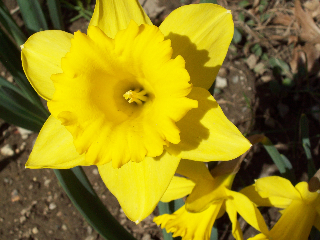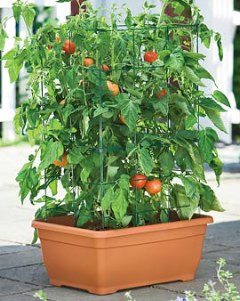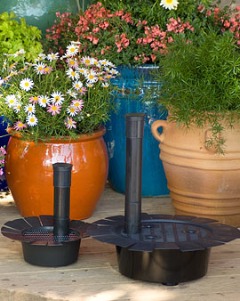Village Condominium Association
Daffodils & Tomatoes
by J. F. Weiler

A host of golden daffodils in a Grant Ave. garden
Photo by J. F. Weiler
Things to Do & Places to Go!
Garden Tour
Hidden Gardens of Beacon Hill. May 19th. Great opportunity to see unique garden designs. info@BeaconHillGardenClub.org
Vegetables & Plants
Allandale Farm, 259 Allandale Road, Brookline is a 250-year-old thirty-acre farm (about twice the acreage of our Village) that offers its own excellent vegetables and plants for sale.
10 a.m. to 6 p.m. Phone 617-524-1531 or www.AllandaleFarm.com
Gore Place, Waltham. Annual Garden Plant Sale.
May 14, 20 & 21st. 9 a.m. to 3 p.m. www.GorePlace.org
Summer Tomatoes
by Dawn Bradley
There is something immensely satisfying about picking a perfectly ripened tomato from the vine, washing it carefully in cool water and then dicing it into juicy pieces, ready for a simple, summer salad. I like to serve salads in a pretty white bowl because it shows off the brightness of the tomatoes' coloring, the golden yellow of the extra virgin olive oil and the deep green of freshly cut basil leaves. Tossed with fresh cut garlic and served with rustic Italian bread, it is a summer feast. As spring nears, I eagerly look forward to this summer ritual and begin planning my container garden.
I am a city girl, loathing dirt under my nails, all types of bugs and creepy crawlers, and the work associated with pulling weeds. Yet, I enjoy picking fresh tomatoes, peppers, or herbs for a simple salad or pizza. Container gardening has proven to be my answer, particularly those containers that are self-watering, so forgiving when I have forgotten to water that day.
If the thought of picking your own fresh fruit, vegetables and herbs intrigues you, you may want to consider the self-watering containers from Gardener's Supply (www.gardeners.com) as they provide all of the essentials for successful, easy gardening. In three years of using the Gardener's Supply Tomato Success kit, I have been rewarded with a bounty of tomatoes each summer.

From the Gardener's Supply website:
Specifications at a Glance:
Kit includes our Self-Watering Planter, Tomato support cage, 40 quarts of Self-Watering Container Mix and 1 pound of organic 5-6-5 fertilizer (contains peanut meal)
Self-Watering Planter: 26" L x 19-3/4" W x 10-1/2" H
Tomato cage: 14-1/2" W x 21-1/2" D x 30" H with 8" legs (38" overall)
Rust-resistant cage clips prevent toppling. For best results, plant two determinate or one indeterminate tomato. Tomato plants not included
Plants thrive when their roots have plenty of access to moisture. The beauty of this kit is that there is sufficient water for the roots to wick when they need the moisture most. I've found that in the heat of summer, I need only replenish a gallon an evening.
The instructions with the kit suggest that the container can accommodate two plants. The first summer, I planted a single plant and was richly rewarded with fruit. I read recently that under optimal conditions and depending upon the type of tomato, a single plant can yield 80 fruit. Though I can't say with certainty, I would guesstimate that my single Roma plant yielded at least 50 fruit.
The second year, I planted a Roma and cherry tomato plant. The cherry tomato plant took over the container garden and, again, I was richly rewarded with fruit, however, the Romas did not thrive as well.
Gardener's Supply also provides conversion kits which proved very helpful in turning decorative planters into thriving herb gardens. Basil, oregano and parsley grow quite well together. Basil is a hearty plant and will grow quite well on its own. Also, a single cherry tomato plant grew heartily in a flower pot with a 16” diameter rim fitted with a self-watering conversion kit.

Self-watering Conversion Kits Create Self-Watering Planters
These Self-Watering Conversion Kits convert your favorite pots into self-watering planters, keeping your plants from drying out and reducing the time you spend watering. Just place this self-contained adjustable reservoir in the bottom of your pot, insert the refill tube and cover with soil. The one-gallon conversion kit holds four quarts and fits pots between 16" and 20" in diameter at the rim. The smaller one-quart conversion kit holds one quart and fits pots up to 10-14" top diameter. Simply fill the reservoir with water through the convenient fill tube. The soil will be moistened through evaporative action from the reservoir below
Planting is best done after the last frost which this year is projected as May 18, or if before, the gardening sites recommend a plant cover so as not to stunt growth.
One last topic to discuss is that of pests, bugs and squirrels. There are good bugs, such as bees, which are essential to pollinate the fruit. Spiders are good bugs because they weave their nets and catch the bad bugs for their own dinner. Planting a marigold plant in with the tomato plant(s) helps deter the bad bugs. They are cheery, hardy flowers so I typically plant a few in their own pot and place the pot near my containers.
Last year was the first year that I dealt with squirrels. Much to my surprise, I woke up to find that they had unplanted all of my freshly planted containers. A colleague recommended coyote urine which can be purchased at a gardening store, however, the gardener at Mahoney's in Brighton recommended against it. Coyote urine may keep away the squirrels and rabbits, however, it will draw coyotes. There are other natural repellants which can be sprayed around the containers and I found that a once a week application of Repels-All proved sufficient.
Hopefully, this article has been helpful and will inspire you to step into the world of container gardening. In ending, a summer pizza recipe that I am looking forward to having soon:
SUMMER PIZZA RECIPE
Ingredients
- Purchased dough, brought to room temperature (I prefer Pizza Roma's)
- Two or three tomatoes, washed and cut width-wise
- Basil, washed and chopped
- Grated mozzarella cheese
Preheat oven to 450 degrees
- Cut dough in half and stretch or roll into a thin, oblong shape
- Place on pizza pan oiled lightly with olive oil
- Lightly brush dough with olive oil
- Sprinkle grated mozzarella cheese
- Place tomatoes
- Sprinkle basil
- Cook for 8-9 minutes; check often as this will cook quickly
- Let sit for a minute or two and then cut with serrated knife
- Eat, enjoy and make the next one!
Written for the May 2011 Village Newsletter.